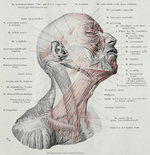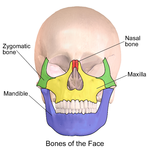Face
This article about biology may be excessively human-centric. (March 2024) |
| Face | |
|---|---|
 Face of a woman (left) and face of a man (right) | |
 Ventrolateral aspect of the human face with skin removed, showing muscles of the face | |
| Details | |
| Identifiers | |
| Latin | facies, facia |
| MeSH | D005145 |
| TA98 | A01.1.00.006 |
| TA2 | 112 |
| FMA | 24728 |
| Anatomical terminology | |
The face is the front of an animal's head that features the
Structure
The front of the human head is called the face. It includes several distinct areas,[3] of which the main features are:
- The forehead, comprising the skin beneath the hairline, bordered laterally by the temples and inferiorly by eyebrows and ears
- The eyes, sitting in the orbit and protected by eyelids and eyelashes
- The distinctive human nose shape, nostrils, and nasal septum
- The cheeks, covering the maxilla and mandible (or jaw), the extremity of which is the chin
- The mouth, with the upper lip divided by the philtrum, sometimes revealing the teeth
Facial appearance is vital for human recognition and communication. Facial muscles in humans allow expression of emotions.[citation needed]
The face is itself a highly
Variability
The face is the feature which best distinguishes a
Shape
The shape of the face is influenced by the bone-structure of the skull, and each face is unique through the anatomical variation present in the bones of the viscerocranium (and neurocranium).[1] The bones involved in shaping the face are mainly the maxilla, mandible, nasal bone and zygomatic bone. Also important are various soft tissues, such as fat, hair and skin (of which color may vary).[1]
The face changes over time, and features common in
Facial shape – such as
Other characteristics
Visible variable features of the face other than shapes and proportions include color (paleness,
Mechanisms underlying these include changes related to
The desire of many to look young for their age and/or attractive
Genetics
Genes are a major factor in the particular appearance of a person's face with the high similarity of faces of identical twins indicating that most of facial variability is determined genetically.[18]
Studies have identified genes and gene regions determining face shape and differences in various facial features. A 2021 study found that a version of a gene associated with lip thickness – possibly selected for due to adaption to cold climate via fat distribution –
Function
Emotional expression
Faces are essential to expressing emotion, consciously or unconsciously. A frown denotes disapproval; a smile usually means someone is pleased. Being able to read emotion in another's face is "the fundamental basis for empathy and the ability to interpret a person's reactions and predict the probability of ensuing behaviors". One study used the Multimodal Emotion Recognition Test[27] to attempt to determine how to measure emotion. This research aimed at using a measuring device to accomplish what many people do every day: read emotion in a face.[28]
The muscles of the face play a prominent role in the expression of emotion,[1] and vary among different individuals, giving rise to additional diversity in expression and facial features.[29]
People are also relatively good at determining if a smile is real or fake. A recent study looked at individuals judging forced and genuine smiles. While young and elderly participants equally could tell the difference for smiling young people, the "older adult participants outperformed young adult participants in distinguishing between posed and spontaneous smiles".[30] This suggests that with experience and age, we become more accurate at perceiving true emotions across various age groups.
Perception and recognition
Gestalt psychologists theorize that a face is not merely a set of facial features, but is rather something meaningful in its form. This is consistent with the Gestalt theory that an image is seen in its entirety, not by its individual parts. According to Gary L. Allen, people adapted to respond more to faces during evolution as the natural result of being a social species. Allen suggests that the purpose of recognizing faces has its roots in the "parent-infant attraction, a quick and low-effort means by which parents and infants form an internal representation of each other, reducing the likelihood that the parent will abandon his or her offspring because of recognition failure".[31] Allen's work takes a psychological perspective that combines evolutionary theories with Gestalt psychology.
Biological perspective
Research has indicated that certain areas of the brain respond particularly well to faces. The fusiform face area, within the fusiform gyrus, is activated by faces, and it is activated differently for shy and social people. A study confirmed that "when viewing images of strangers, shy adults exhibited significantly less activation in the fusiform gyri than did social adults".[32] Furthermore, particular areas respond more to a face that is considered attractive, as seen in another study: "Facial beauty evokes a widely distributed neural network involving perceptual, decision-making and reward circuits. In those experiments, the perceptual response across FFA and LOC remained present even when subjects were not attending explicitly to facial beauty".[33]
Society and culture
Cosmetic surgery
Caricatures
Caricatures often exaggerate facial features to make a face more easily recognized in association with a pronounced portion of the face of the individual in question—for example, a caricature of Osama bin Laden might focus on his facial hair and nose; a caricature of George W. Bush might enlarge his ears to the size of an elephant's; a caricature of Jay Leno may pronounce his head and chin; and a caricature of Mick Jagger might enlarge his lips. Exaggeration of memorable features helps people to recognize others when presented in a caricature form.[36]
Metaphor
By extension, anything which is the forward or world-facing part of a system which has internal structure is considered its "face", like the
See also
References
- ^ ISBN 978-1-60547-652-0.
- ^ "Year of Discovery, Faceless and Brainless Fish". 2011-12-29. Archived from the original on 2014-10-06. Retrieved December 11, 2013.
- ^ Face | Define Face at Dictionary.com. Dictionary.reference.com. Retrieved on 2011-04-29.
- ^ Anatomy of the Face and Head Underlying Facial Expression Archived 2007-11-29 at the Wayback Machine. Face-and-emotion.com. Retrieved on 2011-04-29.
- ^ PMID 19956599.
- ^ S2CID 1546162.
- ^ PMID 31253172.
- ^ S2CID 129634133.
- PMID 32213934.
- S2CID 4487261.
- ^ S2CID 220609978.
- ^ S2CID 149692214.
- ^ S2CID 213518696.
- PMID 35334905.
- ^ PMID 27720464.
- ISBN 9780444538598.
- ISBN 9781118705773.
- PMID 29301965.
- ^ "Genes for face shape identified". phys.org. Retrieved 6 March 2021.
- ^ "Genes for face shape identified | Scienmag: Latest Science and Health News". ScienceMag. Archived from the original on 16 January 2022. Retrieved 6 March 2021.
- PMID 33547071.
- ^ Golembiewski, Kate; Brunelle, François (23 August 2022). "Your Doppelgänger Is Out There and You Probably Share DNA With Them". The New York Times. Retrieved 15 September 2022.
- PMID 36001980.
- S2CID 11364821.
- University press release: "Genes for nose shape found". University College London via ScienceDaily. Retrieved 6 November 2022.
- PMID 28609292.
- ^ "Defining a Face: What Can DNA Phenotyping Really Tell Us About An Unknown Sample?". National Institute of Justice. Retrieved 4 April 2021.
Based on Walsh's phenotype analysis, King determined that one of the earliest paintings of Richard III, the 1510 "Arched Framed Portrait," best matched the genetic information. "We were still dealing with categories [of color] because we're not at the quantitative level yet," Walsh said of her determination of Richard III's hair and eye color. "[King] wanted something physical to see, and that's what spurred me to move toward the quantitative so strongly. Because I could always say to someone, 'blue' or 'blonde,' and they would say, 'I need to see this physically.' So that is what I'm working on now. I want to produce that result." Walsh has gathered DNA phenotype data from 2,000 Irish, Greek and U.S. individuals and is currently collecting data from 3,000 additional individuals from those same countries in order to create a phenotype-genotype database and prediction model. For forensic purposes, she would like to be able to start with a "blank person" and with a sample of DNA, determine the actual eye, hair and skin pigmentation.
- ^ Multimodal Emotion Recognition Test (MERT) | Swiss Center for Affective Sciences Archived 2011-09-03 at the Wayback Machine. Affective-sciences.org. Retrieved on 2011-04-29.
- PMID 19803591. Archived from the original(PDF) on 2017-08-08. Retrieved 2017-11-01.
- ^ Braus, Hermann (1921). Anatomie des Menschen: ein Lehrbuch für Studierende und Ärzte. p. 777.
- PMID 20718538.
- JSTOR 20445341.
- S2CID 13304727.)
{{cite journal}}: CS1 maint: multiple names: authors list (link - PMID 19254086.
- ^ Plastic and Cosmetic Surgery: MedlinePlus. Nlm.nih.gov. Retrieved on 2011-04-29.
- ^ Face Transplant Surgery at Brigham and Women's Hospital
- ^ information about caricatures Archived 2007-08-26 at the Wayback Machine. Edu.dudley.gov.uk. Retrieved on 2011-04-29.
- S2CID 145513767.: "The concept of face is, of course, Chinese in origin".





